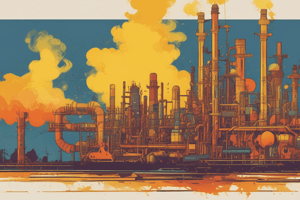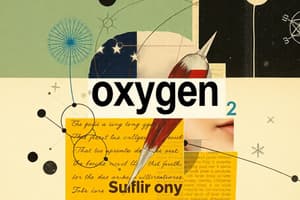Podcast
Questions and Answers
Which of the following statements accurately describes the trend in bond strength for hydrogen compounds within Group VIA (16) elements?
Which of the following statements accurately describes the trend in bond strength for hydrogen compounds within Group VIA (16) elements?
- Hydrogen compounds of Group VIA elements are less stable than Group VA due to lower electronegativity.
- Hydrogen compounds of Group VIA elements show no correlation with electronegativity.
- Hydrogen compounds of Group VIA elements become more stable than Group VA due to higher electronegativity. (correct)
- Hydrogen compounds of Group VIA elements exhibit similar stability to those of Group VA.
How does the covalent character of metal oxides change with the oxidation state of the metal?
How does the covalent character of metal oxides change with the oxidation state of the metal?
- Covalent character increases as the oxidation state increases. (correct)
- Covalent character increases as the oxidation state decreases.
- Covalent character decreases as the oxidation state increases.
- Covalent character remains constant regardless of the oxidation state.
Why are CO, NO, and N2O classified as salt-forming oxides?
Why are CO, NO, and N2O classified as salt-forming oxides?
- They are insoluble in water and do not react with either acids or bases.
- They react vigorously with water to form strong acids.
- These oxides do not form salts. (correct)
- They dissolve in water to form strong bases.
Consider the reaction: $3S + 6NaOH \rightarrow 2Na_2S + Na_2SO_3 + 3H_2O$. What type of reaction is this, and what does it indicate about sulfur?
Consider the reaction: $3S + 6NaOH \rightarrow 2Na_2S + Na_2SO_3 + 3H_2O$. What type of reaction is this, and what does it indicate about sulfur?
How does the thermal stability of metal sulfates generally vary with the activity of the metal?
How does the thermal stability of metal sulfates generally vary with the activity of the metal?
Why do copper sulfide (CuS) dissolve in concentrated nitric acid, but lead sulfide (PbS) does not dissolve in dilute sulfuric acid?
Why do copper sulfide (CuS) dissolve in concentrated nitric acid, but lead sulfide (PbS) does not dissolve in dilute sulfuric acid?
Which of the following best explains why cold concentrated sulfuric acid passivates iron (Fe), aluminum (Al), and chromium (Cr)?
Which of the following best explains why cold concentrated sulfuric acid passivates iron (Fe), aluminum (Al), and chromium (Cr)?
How does the bond energy of $S_2$ compare to that of $O_2$, and what property is associated with $S_2$ at high temperatures?
How does the bond energy of $S_2$ compare to that of $O_2$, and what property is associated with $S_2$ at high temperatures?
Why is oleum considered a strong oxidizing and dehydrating agent?
Why is oleum considered a strong oxidizing and dehydrating agent?
The conversion of $NaHSO_3$ to $Na_2S_2O_5$ involves what type of chemical process, and what is the name of the product?
The conversion of $NaHSO_3$ to $Na_2S_2O_5$ involves what type of chemical process, and what is the name of the product?
Flashcards
Оттегі (Oxygen)
Оттегі (Oxygen)
Most abundant element; 50% of Earth's mass. Reacts readily due to high electronegativity (3.5).
Озон (Ozone)
Озон (Ozone)
Allotropic form of oxygen; blue gas. Stronger oxidizing agent than O₂.
Амфотерлік оксидтер
Амфотерлік оксидтер
Oxides of metals that react with acids and bases.
Күкірт (Sulfur)
Күкірт (Sulfur)
Signup and view all the flashcards
Диспропорциалану реакциясы (Disproportionation reaction).
Диспропорциалану реакциясы (Disproportionation reaction).
Signup and view all the flashcards
Ме + S → Me2Sn
Ме + S → Me2Sn
Signup and view all the flashcards
Олеум (Oleum)
Олеум (Oleum)
Signup and view all the flashcards
H2S
H2S
Signup and view all the flashcards
H2SO4
H2SO4
Signup and view all the flashcards
Study Notes
VI A Group Nonmetals (Oxygen, Sulfur)
- Oxygen is the most abundant element on Earth, accounting for 50% of its mass.
- Oxygen readily reacts with all metallic elements due to its high electronegativity (3.5).
- Hydrogen compounds of group VI A elements are stronger than those of group V A elements because their electronegativity is higher, and conversely, the strength of oxygen compounds of group VI A elements is lower.
- 1400 minerals contain oxygen (quartz, mica, feldspar, clay, limestone).
- A large amount of oxygen exists in chemical bonds and in dissolved form in water.
- The atmosphere contains 1015 tons of oxygen, and the human body is 65% oxygen.
Oxygen Production
- Can be produced by air agitation.
- Electrolysis of water: 2H₂O → electrolysis 2H₂ + O₂
- Laboratory production is achieved:
- 2CrO₃ →t⁰ 2Cr + 3O₂;
- BaO₂(peroxide) →t⁰ Ba + O₂;
- 2KNO₃ →t⁰ 2KNO₂ + O₂;
- 2KClO₃ →t⁰ 2KCl + 3O₂;
- 2KMnO₄ →t⁰ K₂MnO₄ + O₂ + MnO₂;
- Oxygen solubility in water is low (3:100).
- Above 100 km, it exists in atomic form due to UV rays: O₂ → photolysis O + O.
Ozone (O₃)
- Ozone is an allotropic form of oxygen, and its molecule is diamagnetic.
- O₂ is a colorless gas, while O₃ is a blue gas.
- Ozone has higher polarity and polarizability compared to O₂.
- 3O₂ → Electrical discharge 2O₃ (Atmosphere 3O₂ Thunderstorm 2O₃).
- C + 2H⁺ + 2e⁻ → C+H₂O E⁰ = +2.07 V
- O₂ + 4H⁺ + 4e⁻ → 2H₂O E⁰ = +1.23 V.
- Ozone is a potent oxidizer, second only to fluorine in chemical activity.
- It does not react with inert gases, platinum, or gold.
- Oxygen has a maximum covalence of 4 and a valence of II.
- Oxygen reacts with other nonmetals; oxides form covalent bonds because the difference in electronegativity between oxygen and nonmetals is small.
- Nonmetal oxides are gases, volatile liquids, or easily soluble solids.
- Nonmetal oxides dissolve in water to form acids.
- CO, NO, and N₂O are salt-forming oxides, insoluble in water due to strong molecular bonds.
- The acidity of nonmetal oxides increases with the oxidation state of the nonmetal. Examples include:
- P₄O₁₀(solid) + 6H₂O(liquid) = 4H₃PO₄
- SO₃(solid) + H₂O(liquid) = H₂SO₄
- Cl₂O₇(gas) + H₂O(liquid) = 2HClO₄
Metal Oxides
- Metal oxides can be basic, acidic, or amphoteric.
- Alkali and alkaline-earth metal oxides dissolve in water and have ionic bonds.
- The covalent character of metal oxides increases with the oxidation state of the metal.
Peroxides, Superoxides, Ozonides
- K + O₂ → KO₂ (superoxide).
- Potassium ozonides are red.
- K − 1e⁻ → K⁺¹/₂ + 1e⁻ → O₂⁻
- K + O₂ → KO₂ (superoxide).
- K − 1e⁻ → K⁺¹/₂ + 1e⁻ → O₂²⁻
- 2K + O₂ → K₂O₂ (peroxide).
- 2K – 2e⁻ → 2K⁺
- O₂²⁻ + 2e⁻ → O₄²⁻
Production, Properties, and Uses of Sulfur
- Sulfur exhibits IV and VI valences due to the presence of 3d-orbitals.
- Sulfur atoms have strong bonds with each other.
- It constitutes 0.05% of the Earth's surface.
- Found in free state and in sulfide minerals (pyrite, galenite), anhydrite, barite.
- Also found as H₂S gas in mineral water sources.
- Produced from native (free) deposits.
Physical Properties of Sulfur
- At room temperature, it exists as rhombic sulfur (α-sulfur), which is insoluble in yellow water.
- At 94°C, rhombic sulfur transforms into monoclinic (β-sulfur), with S₈-like corona structures.
- sp³ hybridization occurs.
- S₈ 450⁰C ↔ S₆ 650⁰C ↔ S₄ 900⁰C ↔ S₂ 1500⁰C ↔ S
- S₂ is paramagnetic like O₂, while the others are diamagnetic.
Chemical Properties of Sulfur
- Reacts with metals when heated to form sulfides: S + Me →t° Me₂Sn (metal valence dependent).
- S + O₂ → SO₂
- S + X₂ → SX₂ (where X is a halogen).
- 3S + 6NaOH → 2Na₂S + Na₂SO₃ + 3H₂O (disproportionation reaction).
- S + 2e⁻ → S²⁻
- S – 4e⁻ → S⁴⁺
Compounds of Sulfur
- S + O₂ → SO₂ (+4 oxidation state).
- SO₂ + H₂O ↔ H₂SO₃ ↔ H⁺ + HSO₃⁻ ↔ 2H⁺ + SO₃²⁻
- SO₂ + NaOH → NaHSO₃ (hydrosulfite).
- SO₂ + 2NaOH → Na₂SO₃ (sulfite) + H₂O.
- SO₂ can act as both an oxidizing and reducing agent.
- SO₂ + 2H₂S → 3S + 2H₂O.
- 2 Na₂SO₃ + O₂ → 2Na₂SO₄.
- 2 NaHSO₃ (hydrogensulfites) → to Na₂S₂O₅ + H₂O (pyrosulfite), but H₂S₂O₅ (pyrosulfuric acid) does not exist.
- SO₂ + PCl₅ → POCl₃ (oxychloride) + S + OCl₂ (thionyl chloride).
Sulfur as a Reducing Agent
- SOCl₂ + 2H₂O → 2HCl + H₂SO₃.
- Na₂SO₃ + S → Na₂S₂O₃ (thiosulfate).
- Na₂S₂O₃ + HCl → 2NaCl + H₂S₂O₃ (thiosulfuric acid, strong acid, but unstable).
- H₂S₂O₃ → S + SO₂ + H₂O.
- Thiosulfates are reducing agents: Na₂S₂O₃ + I₂ → 2NaI + Na₂S₄O₆.
- S + O₂ + Cl₂ → SO₂Cl₂ (chlorosulfuryl)
Other Reactions of Sulfur Compounds
- SOCl₂ + 2H₂O → 2HCl + H₂SO₄ (in hot water, sulfuryl chloride decomposes).
- 2SO₂ + O₂ → 2SO₃ (catalyzed by NO₂).
- SO₃ + H₂O → H₂SO₄.
Sulfuric Acid (H₂SO₄)
- H₂SO₄ is a colorless, odorless, oily monohydrate.
- Concentrated H₂SO₄ is a strong oxidizing agent.
- Sulfates of alkali and alkaline-earth metals are thermally stable, while less active metals form sulfates that decompose.
- ZnSO₄ → ZnO + SO₃.
- AgSO₄ → 2Ag + SO₂ + O₂.
Thermal Decomposition of Hydrosulfates
- 2NaHSO₄ → to Na₂S₂O₇ + H₂O (disulfate or pyrosulfate).
- H₂S₂O₇ → to H₂SO₄ + SO₃ if dissolved.
- H₂SO₄ with dissolved SO₃ forms oleum (oily substance), a strong oxidizing and dehydrating agent.
Production of Sulfuric Acid
- Contact process (using V₂O₅ catalyst).
- Nitrous process (using NO₂ catalyst).
- Al, Fe, and Cr become passivated by cold, concentrated H₂SO₄ due to the formation of an oxide layer.
- Reactive Metals react with conc. H₂SO₄.
- Me + H₂SO₄ (conc.) → MeSO₄ + H₂S + H₂O
- Metal activity determines products (SO₂, S, H₂S).
- H₂SO₄ (conc.) + Me → no H₂ produced; SO₂, S, or H₂S are formed.
- H₂SO₄ (conc.) oxidizes HI and HBr, but not HCl.
- H₂SO₄ + 8 HI → H₂S + I₂ + 4H₂O.
- H₂SO₄ + 4 HBr → SO₂ + 2Br₂ + 2H₂O.
- Dilute H₂SO₄ + Me → H₂ released + metal sulfate formed. Pb does not react due to PbSO₄ formation.
- H₂SO₄ forms salts such as sulfates and hydrosulfates.
Hydrated Sulfates
- Many sulfates have water of crystallization:
- Na₂SO₄·10H₂O (Glauber's salt).
- CaSO₄·2H₂O (gypsum).
- CaSO₄·0.5H₂O (alabaster).
- CuSO₄·5H₂O.
- FeSO₄·7H₂O (copper and ferrous vitriols).
- Double salts called alums: KAl(SO₄)₂·12H₂O; KCr(SO₄)₂·12H₂O.
Hydrosulfides
- H₂S gas is soluble in water: H₂ + S ↔ H₂S.
- H₂S is a weak acid: H₂S ↔ H⁺ + HS⁻ ↔ H⁺ + S²⁻
- H₂S is poisonous and reacts with Fe²⁺ in hemoglobin.
- H₂S forms sulfides and hydrosulfides, which are soluble in water.
- Colored Sulfides: HgS (red), CdS (yellow), ZnS (white). Alkali and alkaline-earth metal sulfides are water-soluble and undergo hydrolysis. Insoluble in water, but soluble in acids (HCl, H₂SO₄) if EK < 10⁻²⁶. Soluble in nitric acid: CuS + 4HNO₃ (conc.) → Cu(NO₃)₂ + S + NO₂ + 2H₂O.
Studying That Suits You
Use AI to generate personalized quizzes and flashcards to suit your learning preferences.




